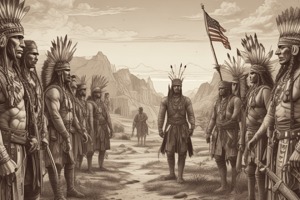Podcast
Questions and Answers
Which group is disproportionately represented in the criminal justice system in the United States?
Which group is disproportionately represented in the criminal justice system in the United States?
- Women
- White men
- Black Americans (correct)
- People of color
What does gender inequality refer to?
What does gender inequality refer to?
- Social and educational dimensions of inequality
- Disparities that exist between individuals or groups in terms of access to resources, opportunities, and outcomes
- Access to resources, opportunities, and outcomes for men and women (correct)
- Systemic barriers and discrimination based on gender
What is a characteristic of the enduring issue of racial inequality?
What is a characteristic of the enduring issue of racial inequality?
- Systemic barriers and discrimination based on race (correct)
- Progress in recent decades
- Disparities between individuals or groups in access to resources
- Significant barriers for achieving gender equality
Where are disparities based on racial inequality often observed?
Where are disparities based on racial inequality often observed?
What is one of the strategies to reduce inequality mentioned in the text?
What is one of the strategies to reduce inequality mentioned in the text?
What is an example of social inequality mentioned in the text?
What is an example of social inequality mentioned in the text?
What barriers do students from disadvantaged backgrounds often face, according to the text?
What barriers do students from disadvantaged backgrounds often face, according to the text?
What is one of the ways to address inequality mentioned in the text?
What is one of the ways to address inequality mentioned in the text?
What is the primary cause of disparities in educational outcomes, as mentioned in the text?
What is the primary cause of disparities in educational outcomes, as mentioned in the text?
What does social inequality encompass, according to the text?
What does social inequality encompass, according to the text?
Flashcards are hidden until you start studying
Study Notes
Inequality: Understanding the Grip on Society
Inequality refers to the disparities that exist between individuals or groups in terms of access to resources, opportunities, and outcomes. It is a complex and multifaceted issue that pervades various aspects of society, including racial, gender, social, and educational dimensions. This article aims to provide an in-depth examination of inequality, focusing on the subtopics of racial inequality, gender inequality, social inequality, and inequality in education.
Racial Inequality
Racial inequality is an enduring issue in many societies, with people of color often facing systemic barriers and discrimination. These disparities can be seen in various aspects of life, including education, employment, and criminal justice. For instance, people of color are more likely to experience poverty, face educational barriers, and be victims of police brutality. In the United States, for example, Black Americans are disproportionately represented in the criminal justice system, with Black men being six times more likely to be incarcerated than White men.
Gender Inequality
Gender inequality refers to the disparities that exist between men and women in terms of access to resources, opportunities, and outcomes. This inequality can be seen in various aspects of life, including education, employment, and healthcare. Despite significant progress in recent decades, women continue to face significant barriers in achieving gender equality. For example, they are often paid less than men for the same work, face underrepresentation in leadership positions, and are subjected to gender-based violence.
Social Inequality
Social inequality is a complex issue that encompasses a wide range of disparities, including those related to income, wealth, and social status. It is often intertwined with other forms of inequality, such as racial and gender inequality. People from lower socioeconomic backgrounds often face significant barriers in accessing quality education, securing good jobs, and receiving adequate healthcare. This can lead to a cycle of poverty and disadvantage that is difficult to break.
Inequality in Education
Inequality in education refers to the disparities that exist in access to quality education based on factors such as race, gender, and socioeconomic status. This can lead to significant disparities in educational outcomes, with students from disadvantaged backgrounds often facing significant barriers to success. For example, they may lack access to quality teachers, resources, and support systems, which can limit their ability to succeed academically and professionally.
Addressing Inequality: A Call to Action
Addressing inequality is a complex and ongoing process that requires sustained efforts at multiple levels, from individual actions to systemic changes. Here are some strategies that can help reduce inequality:
-
Promote diversity and inclusivity: Encourage diversity and inclusivity in all aspects of society, from schools to workplaces. This can help break down barriers and promote greater understanding and respect among different groups.
-
Educate and raise awareness: Increase awareness about the underlying causes of inequality and the ways in which it affects different communities. This can help build a stronger foundation for addressing these issues.
-
Advocate for policy changes: Support and advocate for policies that promote equality and reduce disparities, such as affirmative action, equal pay legislation, and comprehensive education reform.
-
Support grassroots movements: Support and collaborate with grassroots movements and organizations that work to address inequality in various forms.
-
Promote economic justice: Advocate for policies and practices that promote economic justice, such as a living wage, affordable housing, and accessible healthcare.
By taking these steps and working together, we can make significant strides in reducing inequality and creating a more just and equitable society for all.
Studying That Suits You
Use AI to generate personalized quizzes and flashcards to suit your learning preferences.




